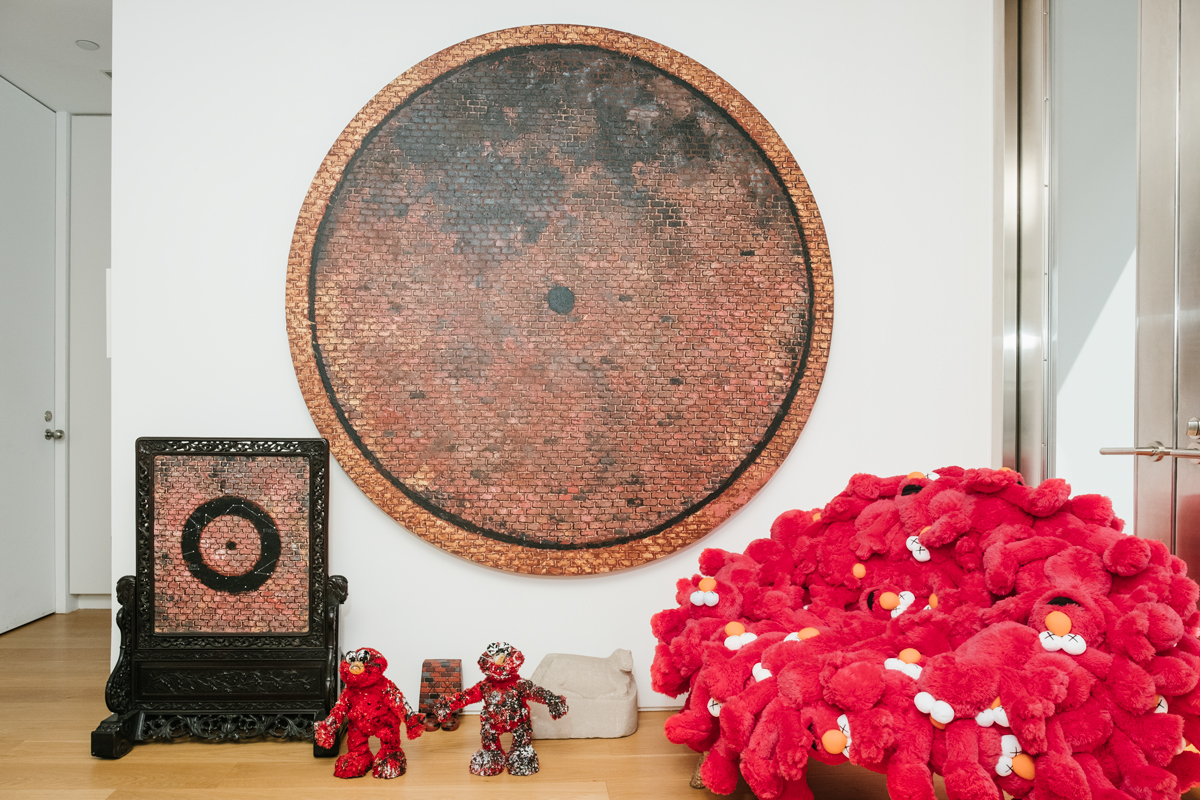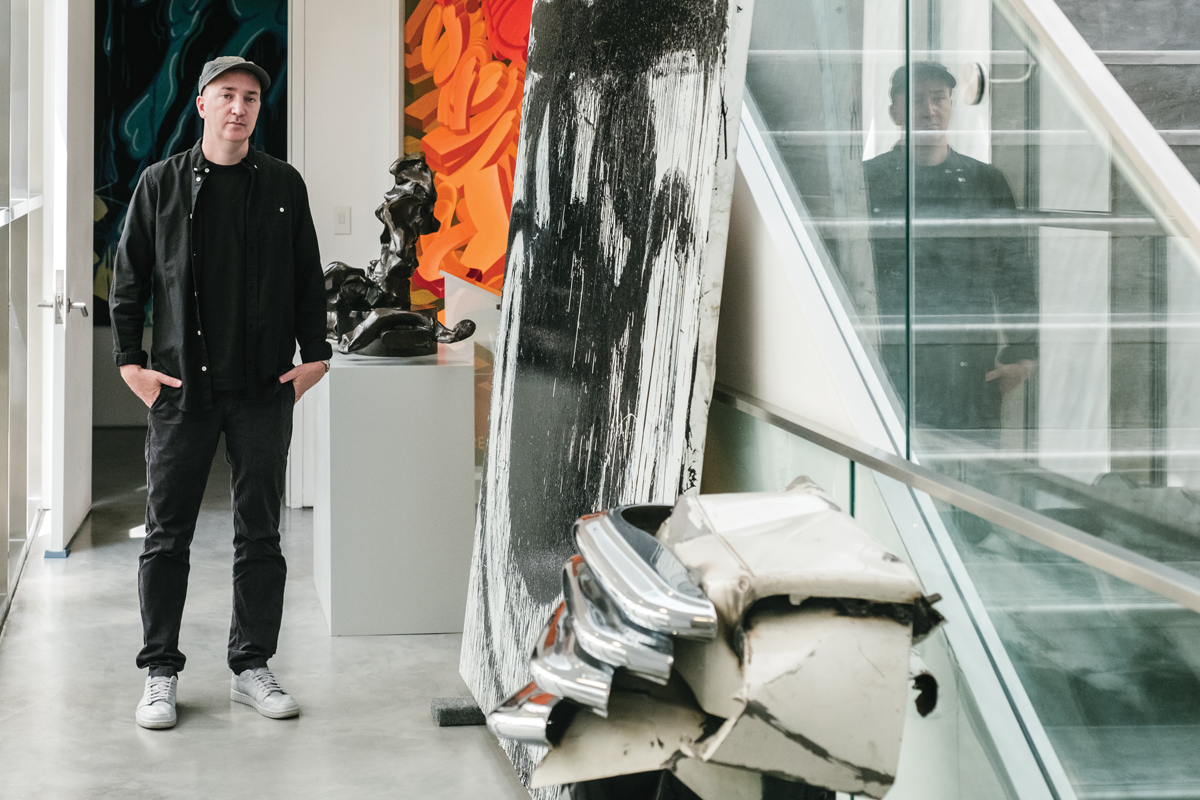[ad_1]

Brian Donnelly in his studio in Brooklyn on a sofa designed by Osvaldo Borsani in 1954 surrounded by riches from his collection.
DONALD STAHL FOR ARTNEWS
In 1999, Brian Donnelly, then in his mid-twenties, dropped by David Zwirner gallery in SoHo to pick up a drawing he’d purchased online for $1,900. It was the first artwork he ever acquired, a drawing of a housefly by Raymond Pettibon. In the upper left corner Pettibon had scrawled the letters SWAK, an acronym for “sealed with a kiss” that also evoked the sound of a flyswatter. For Donnelly, the letters had a third meaning—as the name he used as an artist spelled backward: KAWS.
Donnelly was no stranger to SoHo. Throughout the ’90s—when he was painting his snake-like Bendy character on ads in bus shelters and phone booths—he popped into P.P.O.W. gallery regularly to pepper co-founder Wendy Olsoff with questions about the Chinese-American artist Martin Wong. “She was nice and let me waste her time,” Donnelly said recently, standing next to a painting by Wong that hangs in the Brooklyn home he shares with his wife and two young daughters. “I wanted to buy something but I had no money.” Ten years later, after the gallery had moved to Chelsea and his career had taken off, the situation changed: “Then I could actually buy stuff.”
At this point, Donnelly can afford to buy a lot of stuff. With his huge Companion sculpture floating in Hong Kong’s Victoria Harbor this past March, his painting The Kaws Album (2005) selling the next month for $14.7 million at Sotheby’s Hong Kong, and his T-shirt designs for Uniqlo that have stirred violent shopping frenzies, there is perhaps no artist in the world right now whose work is better known or more recognizable. Nearly unknown, however, is the extent of and variety within Donnelly’s art collection. In certain ways, his collecting is incredibly public: he shares his acquisitions with his 3.2 million Instagram followers, garnering the artists who create those works far more eyeballs than they would get in a museum show. But the story behind his collection, his motivation in assembling it, and the kind of influence he has had on other artists’ markets has not been told.
Donnelly’s Martin Wong holdings are perhaps the most personal part of his collection. Wong’s paintings documenting the Lower East Side of New York in the ’80s have been referred to as works of “visionary realism.” But Donnelly identifies with him in another way, as Wong was a collector and kind of amateur historian of early New York graffiti by artists like Daze (Chris Ellis), Lee Quiñones, Dondi (Donald White), Rammellzee, and others. Wong amassed photographs, paintings, and other materials related to their work and, in 1994, five years before he died of complications from AIDS, donated his collection to the Museum of the City of New York.
While Donnelly is often compared to Keith Haring and Jean-Michel Basquiat—other artists who started out working on the street and progressed into the galleries (and, in Haring’s case, product design for his Pop Shop)—he feels a particular affinity for graffiti artists who inspired him as a teenager in the early ’90s to start putting his KAWS tags on billboards in New Jersey. He is an avid collector of some of their drawings and notebooks, and tucked away in a cabinet in his studio is a sketchbook from graffiti legend Blade that he treats with the same care that one might accord a Picasso.
“In the ’90s, all I heard was that this or that artwork was influenced by graffiti or the streets,” Donnelly said. “This was the top of the pyramid, but no one ever really recognized graffiti for what it is. Can we please acknowledge that fascinating time in the ’70s and ’80s when Lee Quiñones did paintings in the dark that were 10-by-40 feet where he could only step back 5 feet?”
A few years ago, a dealer sold Donnelly a 1980 sign-in book from storied downtown hotspot the Mudd Club, touting the possibility that it contained a Basquiat drawing of Haring. Donnelly cared more about the signatures in the pages that provide a roll call of hip New York at the time—Kim Gordon, George Condo, David Byrne, Rene Ricard—as well as artful scrawls by graffiti “writers” that begin to appear on the date for the opening of “Beyond Words,” an exhibition organized by Haring, Fab 5 Freddy, and Futura 2000. “It turns into kids writing all over the book,” Donnelly said. “These guys are dominating the trains, and you have to imagine them at a gallery just hanging out. It’s a little insight into a time period.”

Works in Donnelly’s studio by Martin Wong, Joyce Pensato, and William Edmonson near KAWS Chair Red (Elmo Plush) by Fernando and Humberto Campana.
DONALD STAHL FOR ARTNEWS
In 2001, around the time he was making his own way into galleries after working in animation and producing a series of limited-edition toys, Donnelly was looking at a group of artists whose work was not so easily integrated into what we think of as fine art. That year, he visited a groundbreaking exhibition titled “Eye Infection” at the Stedelijk Museum in Amsterdam. Curated by Christiaan Braun, the five-artist show charted an alternate path through art history by way of idiosyncratic work by Mike Kelley, Robert Crumb, Jim Nutt, Peter Saul, and H. C. Westermann. Kelley, the one of the bunch with the most conventional art-world bona fides, said unequivocally in an interview at the time, “I think the works of Westermann, Nutt, Crumb, and Saul are part of the avant-garde modernist tradition.”
Writing about the show in Artforum, critic Robert Storr admired the motley crew of artists whose “wayward way with words” had given “art world mandarins an excuse for dismissing them as retrograde anti-intellectuals and therefore beneath serious consideration.” Over time, they had been “creeping up on the motorcade of mainstream painting and sculpture,” Storr wrote. “Now this unruly crew has lurched into the passing lane.”
For Donnelly, the show was a revelation. “These were all the artists I was interested in—it was a great opportunity to see all that work together,” he said. Within a few years, he was collecting all the artists in the show—plus the Crumb-like Basil Wolverton (a Mad magazine and Marvel Comics illustrator who was dubbed a “Producer of Preposterous Pictures of Peculiar People who Prowl this Perplexing Planet”) and Nutt’s fellow Chicago “Hairy Who” artists Karl Wirsum and Gladys Nilsson. He has also acquired numerous works by other so-called outlier artists like Martín Ramírez, Henry Darger, Joe Coleman, and William Edmondson.
“He sees art without prejudice and hierarchies, on a very honest level,” said Wendy Olsoff, the P.P.O.W co-founder. “He sees the sincerity and individualism of each artist.”
In collecting Westermann, Donnelly started with works on paper. “I got into him through his drawings and watercolors,” he said. “Something about them was amazing and got the hook in me, and I started collecting the sculptures. By the time I got to the sculptures, I’d been collecting the drawings for 10 years.”
Recently, Westermann’s work has gained wider acceptance. Donnelly loaned a group of Westermanns for an exhibition at the Reina Sofía in Madrid earlier this year, and for another at the Prada Foundation in Milan in late 2017 curated by Germano Celant. During a Westermann show in 2016 at his Venus Over Manhattan gallery in New York, dealer and collector Adam Lindemann took a liking to Donnelly. “He’s one of the most in-depth, dedicated, knowledgeable, enthusiastic, and devoted collectors I’ve ever met in any field,” Lindemann said. “With his energy and traction in the world of pop culture, he draws inspiration and direction from artists and is helping bring them back into the dialogue. He stepped up when no one would go there.”
But of the “Eye Infection” group, it was Saul whose work provided the firmest foundation for Donnelly’s collecting. Donnelly owns more than 50 works by Saul, ranging from the beginning of his career in the ’50s to the present. He also owns a Philip Guston painting, partly to make a point about Saul’s early work: “So many people see early Saul and say, ‘That’s like Guston.’ I say, ‘Why don’t you look at the date?’ ”

Donnelly with works by CRASH, Peter Saul, Willem de Kooning, Joyce Pensato, and John Chamberlain.
DONALD STAHL FOR ARTNEWS
His interest in Saul has taken Donnelly in different directions. Appreciation of his early work led him to Susan Te Kahurangi King, a New Zealand–born self-taught artist who stopped speaking as a child, and whose work shares with Saul’s a dark, cartoonish quality. “It’s interesting to think of work being made at the same time in a different part of the world,” Donnelly said. “There’s no way she knew what Peter was doing.”
In the living room of Donnelly’s Brooklyn home is Saul’s 1979 painting Double De Kooning Duck, in which the subjects of one of the master Abstract Expressionist’s famous “Woman” paintings become Donald Ducks in Saul’s signature warped, cartoony style. Donnelly bought the painting at Sotheby’s in 2011, setting Saul’s auction record of $272,500 (on a pre-sale estimate of $40,000–$60,000). Saul discovered who bought it and invited Donnelly to his studio. “He was shocked that I would buy that picture,” Donnelly said. “He looks at me as a kid.”
Next to Double De Kooning Duck hangs a more recent acquisition, a 1982 Roy Lichtenstein version of a de Kooning in his comic-influenced Pop style, complete with benday dots. Donnelly has assembled a kind of triad by buying a sculpture by de Kooning. “When you put things next to each other,” he said, “you start to think about them differently.”
Artists doing renditions of other artists’ work is a mini-theme running through Donnelly’s collection. At the top of a stairway in his studio is Saul’s version of Marcel Duchamp’s famous Nude Descending a Staircase, No. 2. In his home is a Tom Sachs sculpture paying scrappy tribute to a famous Brancusi. On Instagram, Donnelly posted a painting he acquired by self-taught artist Marlon Mullen that mimics an iconic Marilyn Monroe by Andy Warhol.
Donnelly collects in many other modes too. Though his collection focuses primarily on the ’50s through the ’80s, he also has works by mid-career artists, including friends like Barry McGee and Eric Parker. He has pieces by Dana Schutz, Mathew Cerletty, Sue Williams, Math Bass, Nicole Eisenman, and Joyce Pensato.
Over the past 18 months, Donnelly has reset the auction record twice for David Wojnarowicz, another hard-to-classify artist who has only recently gotten his due. In addition to Wojnarowicz and Wong, Donnelly owns work by other artists in the P.P.O.W stable, and Olsoff expressed admiration for what she described as the “handmadeness and earnestness” of what he collects.
Two summers ago, Donnelly started collecting abstract paintings by Carolee Schneemann—an artist better known for riotous performance works like Meat Joy (1964)—after he went to Germany to see a Saul retrospective and happened upon a Schneemann show. One of her paintings from 1957 now hangs in his bedroom, across from his Guston. “I walked into that show and was shocked by her paintings,” Donnelly said. “You can have this idea that you know what falls in what category, and you can find out you’re wrong.”
A version of this story originally appeared in the Fall 2019 issue of ARTnews, on newsstands now in select cities, under the title “KAWS & Effect.”
[ad_2]
Source link

